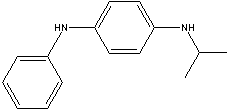PRODUCT IDENTIFICATION

2921.59.9090
Oral rat LD50: 900 mg/kg
N-Phenyl-N'-isopropyl-p-phenylenediamine; 4-(isopropylamino)diphenylamine; N-Isopropyl-N'-phenyl-1,4-phenylenediamine; N-(1-Methylethyl)-N'-phenyl-1,4- benzenediamine; N-Fenyl-N'-isopropyl-p-fenylendiamin; Other RN: 12771-90-3; 59792-63-1; 87133-56-0; 121889-80-3;
SMILES
c1(Nc2ccccc2)ccc(NC(C)C)cc1
CLASSIFICATION
Phenylenediamine, Antioxidant, Antiozonant
PHYSICAL AND CHEMICAL PROPERTIES
> 500 C
REFRACTIVE INDEX
> 150 C
GENERAL DESCRIPTION & EXTERNAL LINKS
IPPD is used as an antioxidant and antiozonant for natural and synthetic elastomers and as an antiflex agent for the protection against catalytic degradation by copper and other heavy metals. p-Phenylenediamine is used as a parent compound in vulcanization accelerators and in antioxidants for rubber industry. PPD is chosen because it imparts high temperature stability, high strength, and chemical and electrical resistance. Examples of the most widely used anitioxidants or antiozonants derived form p-phenylenediamine are N-isopropyl-N'-phenyl-p- phenylenediamine (IPPD, CAS # 101-72-4) , N-Cyclohexyl-N'-phenyl-p- phenylenediamine (CPPD, CAS #: 101-87-1), N,N'-Diphenyl-p-henylenediamine (DPPD, CAS # 74-31-7), and N-(1,3-dimethylbutyl)-N'-phenyl-p-phenylenediamine (6PPD, CAS #: 793-24-8). These derivatives are added to rubber products to retard degradation by oxidants and ozone.
Wikipedia Linking:http://en.wikipedia.org/wiki/Antiozonant
http://www.thefreelibrary.com
Rubber
articles when placed in service can fail prematurely due to ozone
cracking. Ozone is present in the atmosphere at minute levels, about
50 parts per billion (ppb, commonly expressed as five parts per
hundred Million). Ozone can be formed by the action of sunlight
on smog particles, so the level generally increases in summertime
to as high as 300 to 400 ppb, levels which can be harmful to humans
as well as rubber parts. The rubber compounder has several methods
available to protect the rubber part in service against ozone attack.
These various antiozonant techniques will be reviewed in this article.
But first, I would like to make a distinction between oxidation
and ozone attack. Many people confuse the effects of oxygen and
ozone. A common misperception of the neophyte is that once a rubber
compound is well protected against oxidation, it will resist ozone
as well. The incorrect converse is also heard; that the use of antiozonants
eliminates the need for antioxidants.......
http://www.songwonind.com/
Polymer
Stabilizers protect polymers from oxidative damage. They prevent
discoloration and cross linking of polymers during progressing and
ensure long term properties of the finished articles.
Phenolic
Antioxidant(SONGNOX®) is a highly effective, non-discoloring
stabilizer for organic substrates which are prone to oxidation,
e.g. plastics, synthetic fibers, elastomers, waxes, oils and fats.

Aminic Antioxidant maintain physical and surface properties
with good color, excellent anti-scorch, good heat resistance. 
Phosphite
Antioxidant(SONGNOX®) is used to protect organic polymers which
are prone to oxidation, especially during progressing and color
stabilizer......
APPEARANCE
PURITY
95.0% min
70 C min
HEAT LOSS
0.4% max
ASH CONTENT
0.3% max
6.1 (Packing group: III)
2811